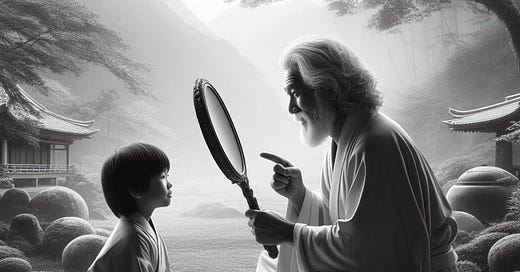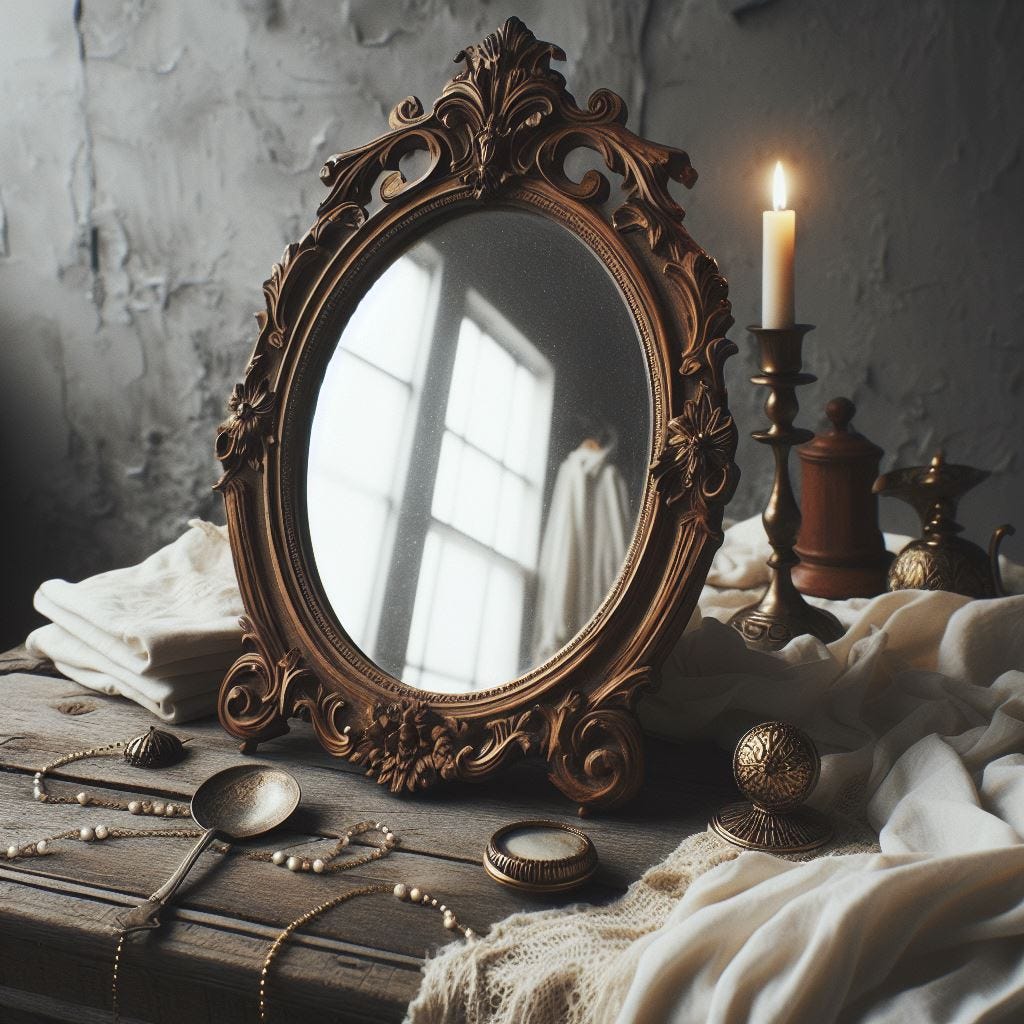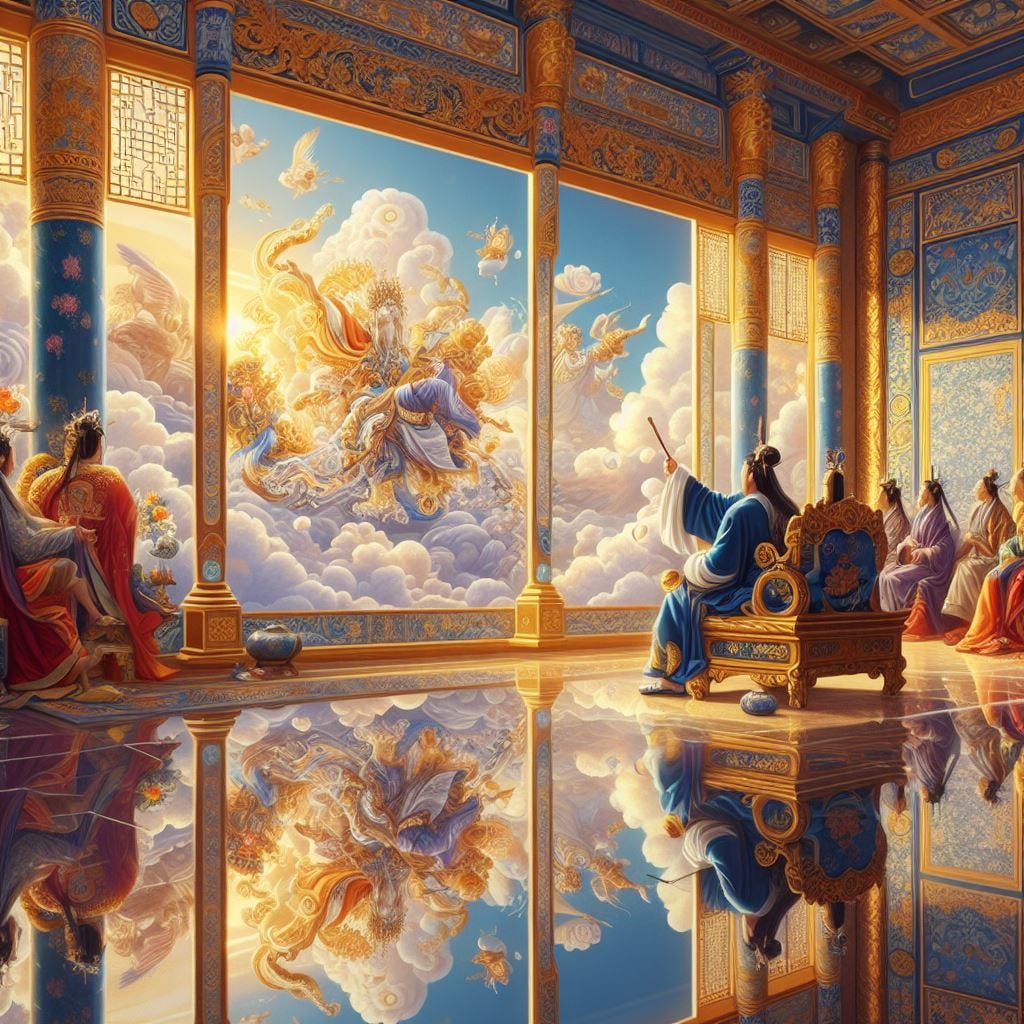Content: Psychology—> Etymology—> Zen Buddhism—> Bonus
Look in the mirror of your heart and you will see the face of the whole cosmos - Rumi
Mirrors are more than objects that reflect our image; they have been key in our self-discovery. The concept is emphasized in Lacan's "mirror stage" theory, where a child's first recognition in the mirror significantly shapes their self-awareness and identity. This moment goes beyond mere reflection; it's a crucial step in understanding ourselves and our place in the world. Let me share the main points from Lacan’s theory that are interesting to me:
During the mirror stage, the child perceives themselves as a whole and distinct entity separate from the external world.
Lacan emphasizes that this self-recognition is an illusion, as it is based on the external image of the mirror, not the child's actual experience of themselves.
This illusory self-recognition lays the foundation for the development of the ego and the formation of one's self-identity.
Lacan suggests that throughout life, individuals continue to seek validation and recognition from external sources, often through mirrors and other people, to maintain their sense of self.
The last point is intriguing, isn’t it? Perhaps we will see different perspectives by the end of the article, and maybe it will transform that pattern into a better one.
Etymology of the word:
But let's take a moment to delve into the etymology of the word 'mirror' itself. It's intriguing to think about how humanity named this reflective tool, and what they might have felt and experienced.
The word "mirror" originates from the Old French 'mireor' or 'mirer' ("to look at"), it traces its roots to the Latin 'miror' ("to wonder at"), and further to 'mirus' (wonderful), with origins in the root '(s)mey,' associated with laughter and joy.
Origin in Old French:
'mireor' or 'mirer': Meaning "to look at."
Latin Roots:
'miror': Translates to "to wonder at."
'mirus': Means "wonderful."
Ancient Root:
'(s)mey': Associated with laughter and joy.
In Latin, Germanic, and English, the term evolved from 'Mey' to 'Mirror,' indicating a reflective tool. In Slavic languages, it became 'sMey' and then 'smeyatsa,' related to laughter. This linguistic evolution reflects our changing relationship with mirrors.
Zen Buddhism Insights:
"It is like the eye that sees everything but cannot see itself. It is like the sword that cuts everything but cannot cut itself."- Zen aphorism
Zen teachings use this metaphor to delve into the nature of the mind. It raises the question: is there an equivalent of a mirror for the mind, and what would it be like if we could view our minds with the same clarity? This idea encourages us to consider the transformative impact of deeply understanding our inner selves, akin to the profound experience of seeing our physical reflection for the first time.
Conclusion:
"The mind is like a mirror; it grasps nothing and refuses nothing. It receives but does not keep."- Zen saying
The word "mirror" reflects our changing understanding of self-reflection. From its joyful origins to today, it shows how mirrors help us see ourselves more clearly, both physically and mentally, guiding our journey of self-discovery. I don't have answers to the questions about this mysterious topic(Perhaps, I have, but it's only for me. You'll find your own answers.). I just wanted to share it with you because it interests me very much.
Bonus: Rumi’s story from Masnavi:
Once, there was a debate between the Chinese and the Greeks to determine who were the superior artists. To resolve this, the king proposed a competition. The Chinese artists began with much enthusiasm, requesting hundreds of colorful dyes for their work. They filled their room with vibrant colors and intricate designs, eagerly working every day. In contrast, the Greek artists asked for nothing. They entered their room and spent their days cleaning and polishing the walls until they shone like a clear sky. The Chinese artists, upon finishing their work, celebrated their achievements with joy. Their room was a spectacle of colors and details, which impressed the king greatly. However, the true surprise came when the Greeks unveiled their work. They pulled back the curtain that divided the rooms, revealing that their polished walls now reflected Chinese art. The images and colors appeared even more beautiful on the Greek walls, changing and shimmering in the light.






